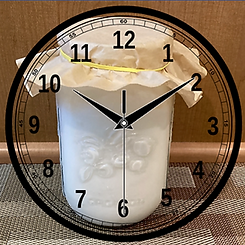How I Make Kefir
Kefir is a fermented milk drink similar to a thin yogurt—tangy, tart and containing more friendly probiotics than regular yogurt.

There are two ingredients: milk and kefir grains. The grains require some fat for optimal performance. Personally, I prefer using 1% milk as I'm not fond of whole milk's taste. Any type of animal milk (cow, goat, sheep) is suitable. Both raw and pasteurized milk can be utilized, but steer clear of ultra-pasteurized milk. Use one teaspoon of kefir grains for every cup of milk.
Supplies include a glass jar, an unbleached coffee filter (muslin, paper, napkin, or any material that can keep out dirt and insects can be used), a rubber band, a small strainer (preferably plastic, but metal is acceptable for brief contact), and a storage container with a lid.

Mix the milk (either cold or at room temperature) with the kefir grains in the glass jar, cover it with the unbleached coffee filter, fastened with a rubber band.

Let the mixture ferment for 12 to 48 hours at room temperature, keeping it out of direct sunlight. Warmer temperatures will speed up the fermentation process, while cooler temperatures will slow it down. The milk is ready when it has thickened and has a tangy flavor. The longer it ferments, the more sour and folate-rich it will become. If it ferments for too long and becomes overly sour, you can use it in baking recipes like banana bread—delicious!

Remove the kefir grains using a strainer. I prefer plastic lids made for seed spouting, but any strainer will work. You can use the grains to start a new batch of kefir, following the same process.

You can either use or consume the prepared milk kefir right away, or you can cover it tightly and store it in a refrigerator.
Avoid letting kefir come into prolonged contact with metal during and after brewing, as this can alter its flavor and weaken the grains over time.
If you need a break from making kefir, simply place the grains in a jar, add fresh milk, cover it tightly, and refrigerate. I've stored mine for up to a month without harming the grains.
Your grains will increase in number over time, and I've noticed they multiply faster with longer fermentations. Then it’s a great opportunity to share with others!
It's normal for kefir to separate into a solid layer and a milky layer during fermentation or when stored in the fridge. Just shake the jar or stir gently to mix it back together. To prevent this, start checking your kefir sooner.
I usually let my kefir and grains sit for several days on the counter until distinct layers form, as shown in my photo. I then gently stir with a plastic spoon before straining into a measuring cup using a small plastic strainer, which works perfectly.